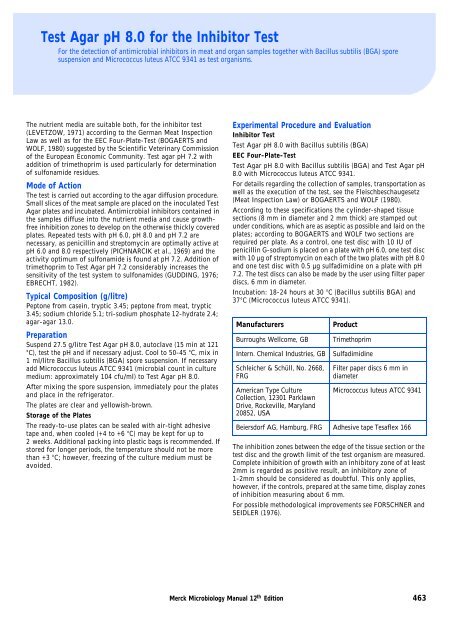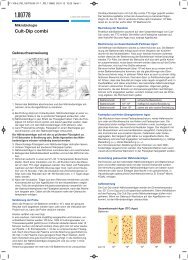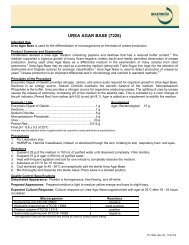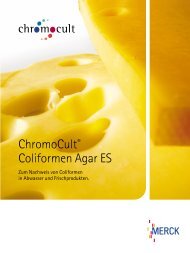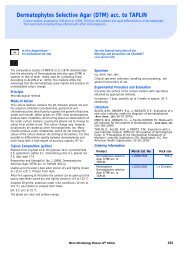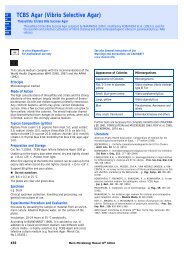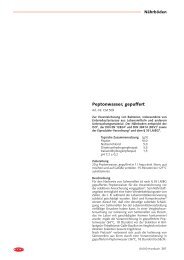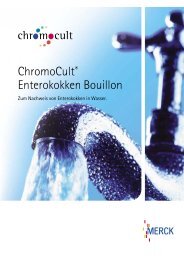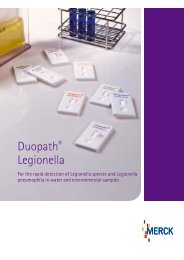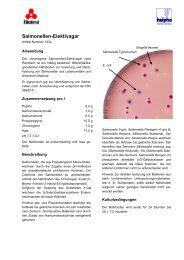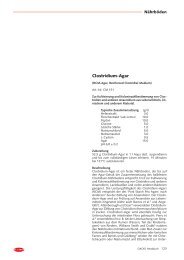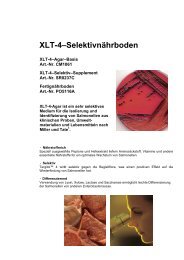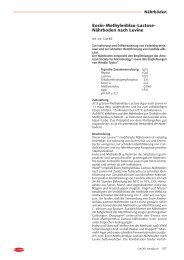Test Agar pH 8.0 for the Inhibitor Test - mibius
Test Agar pH 8.0 for the Inhibitor Test - mibius
Test Agar pH 8.0 for the Inhibitor Test - mibius
Create successful ePaper yourself
Turn your PDF publications into a flip-book with our unique Google optimized e-Paper software.
<strong>Test</strong> <strong>Agar</strong> <strong>pH</strong> <strong>8.0</strong> <strong>for</strong> <strong>the</strong> <strong>Inhibitor</strong> <strong>Test</strong><br />
For <strong>the</strong> detection of antimicrobial inhibitors in meat and organ samples toge<strong>the</strong>r with Bacillus subtilis (BGA) spore<br />
suspension and Micrococcus luteus ATCC 9341 as test organisms.<br />
<strong>Test</strong> <strong>Agar</strong> <strong>pH</strong> <strong>8.0</strong> <strong>for</strong> <strong>the</strong> <strong>Inhibitor</strong> <strong>Test</strong><br />
The nutrient media are suitable both, <strong>for</strong> <strong>the</strong> inhibitor test<br />
(LEVETZOW, 1971) according to <strong>the</strong> German Meat Inspection<br />
Law as well as <strong>for</strong> <strong>the</strong> EEC Four-Plate-<strong>Test</strong> (BOGAERTS and<br />
WOLF, 1980) suggested by <strong>the</strong> Scientific Veterinary Commission<br />
of <strong>the</strong> European Economic Community. <strong>Test</strong> agar <strong>pH</strong> 7.2 with<br />
addition of trimethoprim is used particularly <strong>for</strong> determination<br />
of sulfonamide residues.<br />
Mode of Action<br />
The test is carried out according to <strong>the</strong> agar diffusion procedure.<br />
Small slices of <strong>the</strong> meat sample are placed on <strong>the</strong> inoculated <strong>Test</strong><br />
<strong>Agar</strong> plates and incubated. Antimicrobial inhibitors contained in<br />
<strong>the</strong> samples diffuse into <strong>the</strong> nutrient media and cause growthfree<br />
inhibition zones to develop on <strong>the</strong> o<strong>the</strong>rwise thickly covered<br />
plates. Repeated tests with <strong>pH</strong> 6.0, <strong>pH</strong> <strong>8.0</strong> and <strong>pH</strong> 7.2 are<br />
necessary, as penicillin and streptomycin are optimally active at<br />
<strong>pH</strong> 6.0 and <strong>8.0</strong> respectively (PICHNARCIK et al., 1969) and <strong>the</strong><br />
activity optimum of sulfonamide is found at <strong>pH</strong> 7.2. Addition of<br />
trimethoprim to <strong>Test</strong> <strong>Agar</strong> <strong>pH</strong> 7.2 considerably increases <strong>the</strong><br />
sensitivity of <strong>the</strong> test system to sulfonamides (GUDDING, 1976;<br />
EBRECHT, 1982).<br />
Typical Composition (g/litre)<br />
Peptone from casein, tryptic 3.45; peptone from meat, tryptic<br />
3.45; sodium chloride 5.1; tri-sodium phosphate 12-hydrate 2.4;<br />
agar-agar 13.0.<br />
Preparation<br />
Suspend 27.5 g/litre <strong>Test</strong> <strong>Agar</strong> <strong>pH</strong> <strong>8.0</strong>, autoclave (15 min at 121<br />
°C), test <strong>the</strong> <strong>pH</strong> and if necessary adjust. Cool to 50-45 °C, mix in<br />
1ml/litre Bacillus subtilis (BGA) spore suspension. If necessary<br />
add Micrococcus luteus ATCC 9341 (microbial count in culture<br />
medium: approximately 104 cfu/ml) to <strong>Test</strong> <strong>Agar</strong> <strong>pH</strong> <strong>8.0</strong>.<br />
After mixing <strong>the</strong> spore suspension, immediately pour <strong>the</strong> plates<br />
and place in <strong>the</strong> refrigerator.<br />
The plates are clear and yellowish-brown.<br />
Storage of <strong>the</strong> Plates<br />
The ready-to-use plates can be sealed with air-tight adhesive<br />
tape and, when cooled (+4 to +6 °C) may be kept <strong>for</strong> up to<br />
2weeks. Additional packing into plastic bags is recommended. If<br />
stored <strong>for</strong> longer periods, <strong>the</strong> temperature should not be more<br />
than +3 °C; however, freezing of <strong>the</strong> culture medium must be<br />
avoided.<br />
Experimental Procedure and Evaluation<br />
<strong>Inhibitor</strong> <strong>Test</strong><br />
<strong>Test</strong> <strong>Agar</strong> <strong>pH</strong> <strong>8.0</strong> with Bacillus subtilis (BGA)<br />
EEC Four-Plate-<strong>Test</strong><br />
<strong>Test</strong> <strong>Agar</strong> <strong>pH</strong> <strong>8.0</strong> with Bacillus subtilis (BGA) and <strong>Test</strong> <strong>Agar</strong> <strong>pH</strong><br />
<strong>8.0</strong> with Micrococcus luteus ATCC 9341.<br />
For details regarding <strong>the</strong> collection of samples, transportation as<br />
well as <strong>the</strong> execution of <strong>the</strong> test, see <strong>the</strong> Fleischbeschaugesetz<br />
(Meat Inspection Law) or BOGAERTS and WOLF (1980).<br />
According to <strong>the</strong>se specifications <strong>the</strong> cylinder-shaped tissue<br />
sections (8 mm in diameter and 2 mm thick) are stamped out<br />
under conditions, which are as aseptic as possible and laid on <strong>the</strong><br />
plates; according to BOGAERTS and WOLF two sections are<br />
required per plate. As a control, one test disc with 10 IU of<br />
penicillin G-sodium is placed on a plate with <strong>pH</strong> 6.0, one test disc<br />
with 10 µg of streptomycin on each of <strong>the</strong> two plates with <strong>pH</strong> <strong>8.0</strong><br />
and one test disc with 0.5 µg sulfadimidine on a plate with <strong>pH</strong><br />
7.2. The test discs can also be made by <strong>the</strong> user using filter paper<br />
discs, 6 mm in diameter.<br />
Incubation: 18-24 hours at 30 °C (Bacillus subtilis BGA) and<br />
37°C (Micrococcus luteus ATCC 9341).<br />
Manufacturers<br />
Burroughs Wellcome, GB<br />
Intern. Chemical Industries, GB<br />
Schleicher & Schüll, No. 2668,<br />
FRG<br />
American Type Culture<br />
Collection, 12301 Parklawn<br />
Drive, Rockeville, Maryland<br />
20852, USA<br />
Product<br />
Trimethoprim<br />
Sulfadimidine<br />
Filter paper discs 6 mm in<br />
diameter<br />
Micrococcus luteus ATCC 9341<br />
Beiersdorf AG, Hamburg, FRG Adhesive tape Tesaflex 166<br />
The inhibition zones between <strong>the</strong> edge of <strong>the</strong> tissue section or <strong>the</strong><br />
test disc and <strong>the</strong> growth limit of <strong>the</strong> test organism are measured.<br />
Complete inhibition of growth with an inhibitory zone of at least<br />
2mm is regarded as positive result, an inhibitory zone of<br />
1-2mm should be considered as doubtful. This only applies,<br />
however, if <strong>the</strong> controls, prepared at <strong>the</strong> same time, display zones<br />
of inhibition measuring about 6 mm.<br />
For possible methodological improvements see FORSCHNER and<br />
SEIDLER (1976).<br />
Merck Microbiology Manual 12 th Edition 463
<strong>Test</strong> <strong>Agar</strong> <strong>pH</strong> <strong>8.0</strong> <strong>for</strong> <strong>the</strong> <strong>Inhibitor</strong> <strong>Test</strong><br />
Literature<br />
Arbeitsgruppe des Instituts für Lebensmitteltechnologie und Verpackung der<br />
Technischen Universität München: Merkblätter für die Prüfung von Packmitteln,<br />
Merkblatt 18 "Prüfung auf antimikrobielle Bestandteile in Packstoffen".<br />
- Verpackgs.-Rdsch., 25; Techn.-wiss. Beilagen; 5-8 (1974).<br />
BAUR, E.: Untersuchungen von Fleisch- und Wurstwaren mit dem Hemmstofftest<br />
im Rahmen der tierärztlichen Lebensmittelüberwachung. -<br />
Fleischwirtsch., 55; 843-845 (1975)<br />
BOGAERTS, R., u. WOLF, F.: Eine standardisierte Methode zum Nachweis von<br />
Rückständen antibakteriell wirksamer Substanzen in frischem Fleisch.<br />
- Fleischwirtsch., 60; 667-675 (1980).<br />
Deutsches Fleischbeschaugesetz: Ausführungsbestimmungen A über die<br />
Untersuchung und gesundheitspolizeiliche Behandlung der Schlachttiere und<br />
des Fleisches bei Schlachtungen im Inland; Anlage 4 zu § 20 Abs. 4: Rückstandsuntersuchung.<br />
EBRECHT, A.: Verbesserung des Hemmstofftestes durch Zusatz von<br />
Trimethoprim zum Nachweis von Sulfonamiden. - Arch. Lebensmittelhyg.<br />
33; 109-115 (1982).<br />
FORSCHNER, E., u. SEIDLER, M.: Alternativvorschläge zum Hemmstofftest.<br />
Rationalisierung und Absicherung. - Fleischwirtsch., 56; 1008-1013 (1976).<br />
GUDDING, R.: An improved bacteriological method <strong>for</strong> <strong>the</strong> detection of<br />
sulfonamide residues in food. - Acta Vet. Scand., 17; 458-464 (1976).<br />
LEVETZOW, R.: Untersuchungen auf Hemmstoffe im Rahmen der<br />
Bakteriologischen Fleischuntersuchung (BU). - Bundesgesundheitsblatt, 14;<br />
15/16, 211-213 (1971).<br />
PICHNARCIK, J., WENZEL, S., u. GISSKE, W.: Beitrag zur Methodik des<br />
Hemmstoffnachweises in Organen und Muskulatur von Schlachttieren.<br />
- Arch. Lebensmittelhyg., 20; 272-279 (1969).<br />
Ordering In<strong>for</strong>mation<br />
Product Merck Cat. No. Pack size<br />
<strong>Test</strong> <strong>Agar</strong> <strong>pH</strong> <strong>8.0</strong> <strong>for</strong> <strong>the</strong><br />
<strong>Inhibitor</strong> <strong>Test</strong><br />
Bacillus subtilis<br />
(BGA)-spore suspension<br />
Penicillin G potassium salt<br />
Streptomycin sulfate<br />
1.10664.0500 500 g<br />
1.10649.0001 15 x 2 ml<br />
CN Biosciences<br />
CN Biosciences<br />
Quality control<br />
<strong>Test</strong> strains<br />
Bacillus subtilis strain BGA<br />
(DSMZ 618)<br />
Inhibition zones in mm Ø<br />
Growth Gentamicin Penicillin Streptomycin<br />
good /<br />
very good<br />
Micrococcus luteus ATCC 9341 good /<br />
very good<br />
10 µg 30 µg 10 IU 10 µg<br />
36-44 38-47 34-45 30-36<br />
28-36 32-40 50-60 30-36<br />
BGA Micrococcus luteus ATCC 9341<br />
464 Merck Microbiology Manual 12 th Edition


